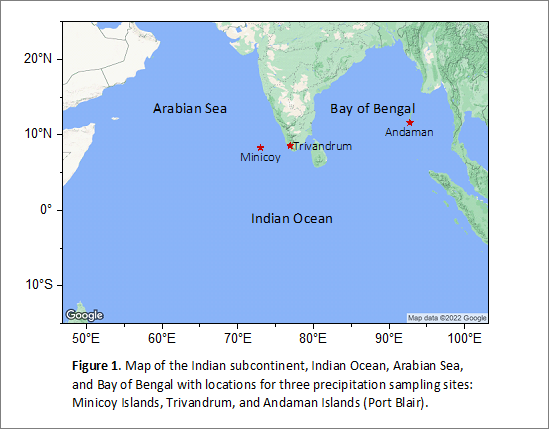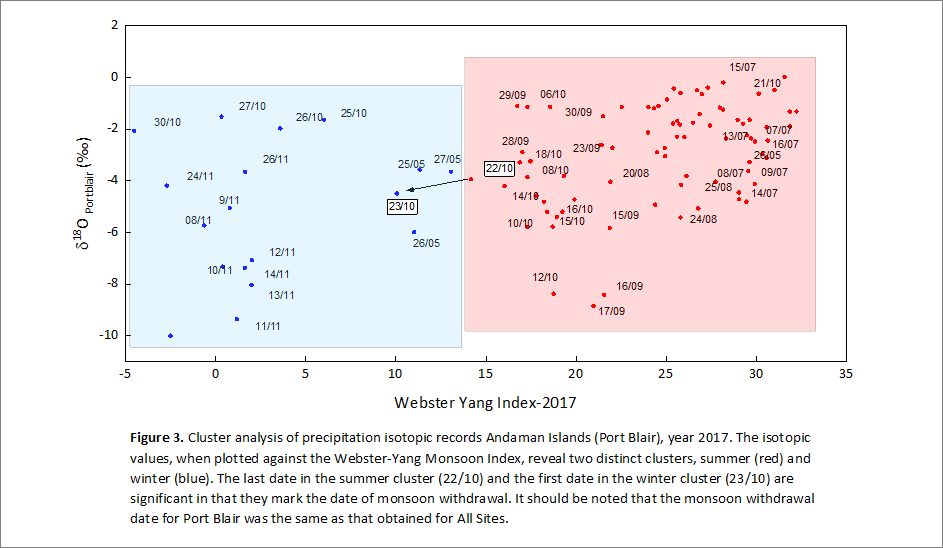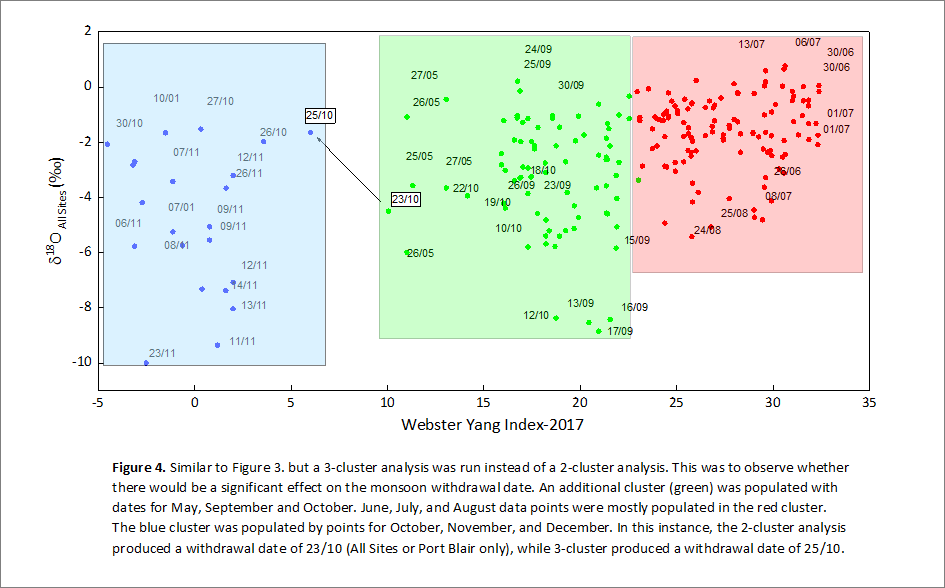A Geochemical Tracer Method for Estimating Monsoon Withdrawal Date
Organization
Dr. Supriyo Chakraborty
Center for Climate Change Research
Indian Institute of Tropical Meteorology (IITM)
Pune, India
Problem
The southwest monsoon has broad economic and social impacts on life on the Indian subcontinent. Thus, there is considerable interest in predicting the onset and withdrawal dates of the monsoon. While the onset is accompanied by distinct changes in meteorological parameters (e.g. wind speed, rainfall), the withdrawal is characterized by slow changes in these parameters, making it difficult to identify a withdrawal date.
Solution
Researchers have proposed a new method for dating the withdrawal that involves isotopic analysis of rainwater collected at sites in the Bay of Bengal and the Arabian Sea. Cluster analysis of data revealed distinct "summer" and "winter" clusters when isotopic values were plotted against a monsoon circulation index. On the basis of these findings, researchers have proposed a new "geochemical tracer" method for dating monsoon withdrawal.
“ Since agricultural activities depend heavily on monsoon rainfall, the estimation of monsoon onset and withdrawal dates are considered an essential component of monsoon research.”
Dr. Supriyo Chakraborty served as Project Director of the MetFlux Project of the Indian Institute of Tropical Meteorology (IITM) in Pune, India from 2012 until June 2022. Dr. Chakraborty writes that "the MetFlux Project endeavors to quantify the carbon fluxes between the atmosphere and biosphere at a few forest ecosystems in India. One of the components of this project is to study the link between the carbon cycle and the hydrological cycle. We measure isotopic values of rainfall and the ecosystem productivity (that is, carbon fluxes) to establish the link. We have recently published a paper involving the above-mentioned measurements" (1).
We asked Dr. Chakraborty to discuss another project that he was recently involved in, a study to better define the withdrawal timing of the southwest monsoon over the Indian subcontinent.

The goals of this project were:
- To examine the role of the low-level monsoon circulation on the precipitation isotopic composition over the Indian region.
- To study how precipitation isotopes respond to the tropospheric temperature variability.
- To propose that geochemical tracers, such as the precipitation isotope, could be used to estimate the monsoon withdrawal dates.
- To establish precipitation isotopes' potential in getting the monsoon information on past time scales.
"The arrival and departure of southwest monsoon play an essential role in the economic and societal aspects of the Indian subcontinent. Since agricultural activities depend heavily on monsoon rainfall, the estimation of monsoon onset and withdrawal dates are considered an essential component of monsoon research. Sharp changes in the meteorological variables (wind speed, rainfall, etc.) characterize the arrival of the monsoon in late May to early June. For example, the strength of the south-westerly winds over south peninsular India increases rapidly, which provides a means to estimate the monsoon onset date with reasonable skill. Nevertheless, the meteorological parameters change very slowly when the monsoon recedes at the end of September to early October.
“ Our study proposes a new technique for estimating the monsoon withdrawal date over India based on the isotopic analysis of rainfall over the Andaman Islands in the Bay of Bengal and the Minicoy Islands over the Arabian Sea. ”
"As a result, the estimation of monsoon withdrawal date often suffers from considerable error. Various methods are available to determine the monsoon withdrawal date, but all rely on analyzing meteorological parameters, such as rainfall, wind speed, temperature, humidity, etc. Our study proposes a new technique for estimating the monsoon withdrawal date over India based on the isotopic analysis of rainfall over the Andaman Islands in the Bay of Bengal and the Minicoy Islands over the Arabian Sea.

We asked Dr. Chakraborty how Origin had been helpful in achieving his research goals and he responded that "one of the important aspects of this work is to apply the cluster analysis technique that estimates the monsoon withdrawal date as described above. The cluster analysis tool in Origin is extensively used for this purpose", noting that he and colleagues had also used OriginPro's principal components analysis tool extensively in other studies (3)."
"We collected rainwater from these islands and measured their oxygen (and hydrogen) isotopic ratios. We have demonstrated that two distinct clusters are formed when the isotopic values are plotted against a monsoon circulation index. One cluster represents the summer season, while the other stands for the winter. Each point in these clusters is identified with the corresponding date. The ‘last date’ identified in the summer cluster and the ‘first date’ identified in the winter cluster provide a means to estimate the monsoon withdrawal date. We have used a large number of data covering several years, making the technique statistically robust. The new method, that is the use of a geochemical tracer in estimating the monsoon withdrawal date, has the potential to get the past monsoon information retrieved from the natural archives" (2).
“ We have used OriginPro software to perform the cluster analysis. Each point in these clusters is identified with the corresponding date. The ‘last date’ identified in the summer cluster and the ‘first date’ identified in the winter cluster provide a means to estimate the monsoon withdrawal date. ”


When asked about other insights gained from this study, Dr. Chakraborty noted that "Figure 5. reveals an interesting feature of precipitation isotopes. Here the x-axis represents the thermodynamic characteristics of the monsoon. When it rains, a significant amount of latent heat is released. This makes the troposphere over the Indian landmass warm relative to the troposphere over the Indian Ocean from where moisture is generated and transported to the Indian landmass. The tropospheric temperature difference, when multiplied by time, gives rise to a 'thermodynamic index' of monsoon known as TISM (Thermodynamic Index of Summer Monsoon). The graph to the left shows that precipitation isotopes maintain a significant positive correlation with TISM. Unlike the thermodynamic index, the precipitation isotopes maintain a weak correlation with the ISMR. This means that precipitation isotopes respond better to the thermodynamics of the atmosphere than the rainfall amount. This characteristic feature of the precipitation isotopes may have the potential to reconstruct past monsoon rainfall variability."

“ Origin provides a powerful means to do statistical calculations and present the results in an impressive manner.”
Though Dr. Chakraborty retired in June of 2022, he continues to pursue his research interests: "I am still analysing the precipitation isotope data and other data for which I am extensively using Origin. I do plan to use it for the next several years and I am very keen to learn the new features of Origin. I especially like to use its feature of handling the NetCDF data format." He further notes, "I found Origin provides a powerful means to do various statistical calculations and present the results in an impressive manner. Other than the paper mentioned above, my students and I have used Origin outputs in several of my papers. I always try to motivate my students to use Origin. In the past few years several of my students learned and used this software."
References
(1) Linkage between precipitation isotopes and biosphere-atmosphere interaction observed in northeast India
(2) Modulation of the Precipitation Isotopes by the Dynamic and Thermodynamic Variables of the Atmosphere in Southern Parts of India
(3) Quantifying the net ecosystem exchange at a semi-deciduous forest in northeast India from intra-seasonal to the seasonal time scale